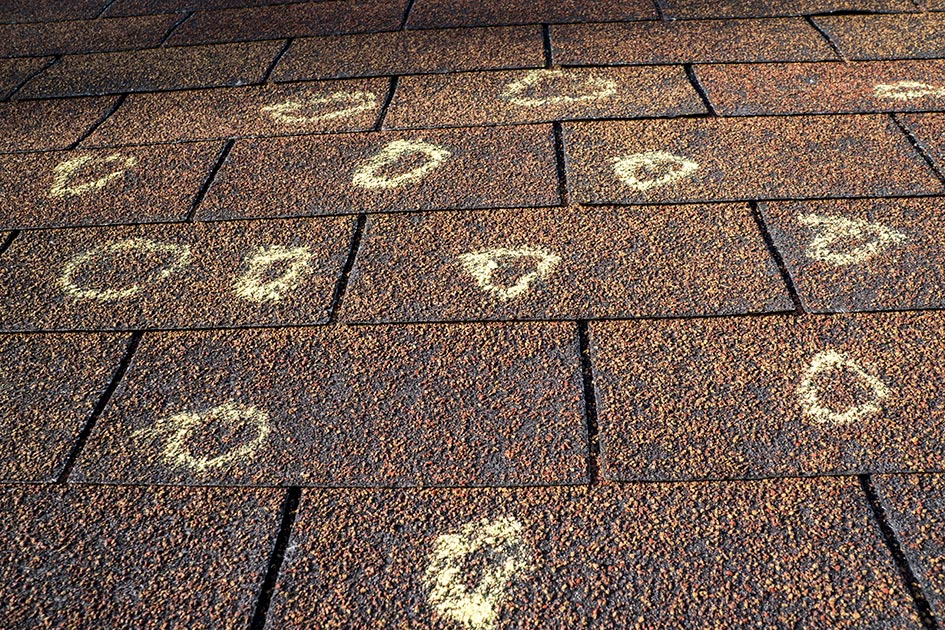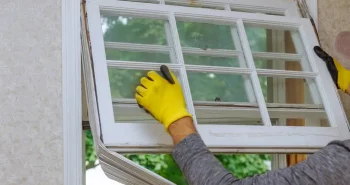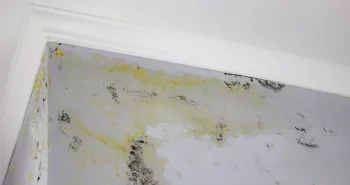Hail damage can lead to serious issues on your roof, siding, and exposed vehicles, often resulting in extensive roof damage. Unfortunately, hailstorms are unpredictable in both severity and timing, making it hard to prepare. While you can protect your vehicle when not in use, there’s little you can do to shield your roof. The best approach is to act quickly after a hailstorm, getting a professional roofing contractor for a roof inspection and addressing any damage immediately. The extent of hail damage varies with the hail size, from pea- to baseball-sized stones. If large hailstones fall, be sure to take cover. Once the storm passes, follow these seven steps to assess the damage, have your roof inspected, and consider filing an insurance claim if needed.
How to Assess Damage After a Hailstorm
How you assess the damage to your home after a hailstorm matters, especially if you plan to file a claim with your insurance company. Take your time and work through the steps below, but if you notice any major problems like a severe roof leak or broken appliance, call a professional for emergency services as soon as possible. You should always focus your attention on potentially hazardous or dangerous situations before anything else.
1. Record Date and Time of the Hail
One of the first things you’ll need to do when a hailstorm affects your property is record the date and time. This is fairly straightforward and may seem a little unnecessary in the moment, but your insurance company will ask for this information to verify it with local weather reports. This will give you confidence that damage incurred will be taken care of—if your policy covers includes protection.
2. Take Photos of Your Property
After the hailstorm is over, when it’s safe to go outside, walk around and take pictures of everything. This should include pictures of any hail remnants, preferably with a reference item in the shot to help display the size of the stones. You can never have too many pictures, so don’t be afraid to go overboard and create an album in your phone. In addition to the hail stone, pictures should include areas where there’s hail covering the ground or surfaces of your home, car, or property, damage to any outdoor appliances, damages that are seen on the siding or roof, landscaping damage, broken windows or other glass, and any active water leaks that may have occurred following a hailstorm.
Hailstorms have the potential to cause extensive hail damage to your property, some of which may not be visible at first. By taking photo documentation, you’ll be more prepared to show causes of damage that’s found after an inspection or emergent problems.
3. Clean Potential Hazards from Your Yard
Once you’re done taking pictures, it’s recommended to start cleaning up any broken glass or other hazards throughout your yard. This is especially important if you have children or pets.
If there are any situations that may require outside help, address those first. For example, if your roof is leaking or if you have broken windows, you’ll want to call a contractor as soon as possible to get them scheduled for repair. This will help you keep your home safe and reduce the risk of further damage. Next, clean any shattered windows or glass structures and make sure that you’re wearing thick gloves to protect your hands. Then, move on to damaged landscaping such as broken branches, messy flower beds, or shrubbery.
While calling a contractor is important to take care of leaks, you’ll still want to temporarily stop the water flow to avoid incurring extensive water damage. There are options for temporary roof repairs through companies that offer emergency services, or you can use a tarp to help mitigate water flow. If you’re unable to stall the leak safely on your own, wait for the appropriate help to arrive and try to remove any items from your home that may be damaged in the meantime.
4. Conduct a Visual Inspection
Only after you’ve taken pictures, cleaned up potentially dangerous hazards, and addressed emergency situations should you begin your thorough inspection. Walk around your property and take a closer look at your siding and the roof. If you found any roof shingles when cleaning up your yard, it’s likely they came from your home and will need to be replaced. Keep a list of everything you find during your visual inspection to help direct professionals to the most urgent areas. If you see any large debris on your roof, missing metal fascia, warping or sagging rooflines, or find that your gutter system has been damaged, contact a professional. The sooner these problems are addressed, the easier they’ll be to get repaired. The same visual inspection should be applied to your home’s siding.
5. Find a Reputable Roofing Contractor
The next step is finding a reputable roofing contractor. Regardless of if you have any significant damage, you should undergo a professional inspection to be sure. During this time, they’ll inspect your roof and siding for signs of damage that may go unnoticed to the untrained eye. This includes small cracks, loose tiles, damage to the siding, or other issues that may not have been noticed from the ground. Following their inspection, they’ll provide you with recommendations for repair along with an estimate. This can be given to your insurance company along with your documentation during your claim.
Always take the time to vet your roofing contractors. You should hire experienced professionals who prioritize communication and customer satisfaction. This will give you the confidence you need when undergoing repairs. While hailstorms can make homeowners feel vulnerable, avoid accepting any free inspections from salespeople going door to door. These types of workers have a reputation for performing inadequate roofing repairs and then disappearing when things go wrong. There are also a lot of scammers who try to collect insurance proceeds. Do your research, ask for references, and check their website to ensure you’re working with a reputable, trustworthy company.
6. Contact Your Insurance Company
Another important action to take following a hailstorm is to contact your insurance company. Usually, the sooner you do this, the better. However, many insurance providers give you a window of about six to 24 months to report damages caused by storms. Always double check this window as you don’t want to miss it and have to pay for repairs out of pocket. They may ask to perform their own inspection or inquire about inspections made by a reputable company.
Before going through with a claim, consider the overall costs of repair. Sometimes, filing a claim can cause insurance rates to rise past the amount that it costs to fix any sustained damage. These details will vary based on your policy and extent of coverage, so it’s always important to undergo a thorough examination and, if you have questions, talk with a representative from your insurance company.
If you decide to move forward with filing a claim, do it as soon as possible to ensure adequate coverage. Always keep your receipts for any work done within the scope of your claim so you can submit thorough documentation when things are done.
7. Repair Any Damages
Next, confirm your coverage with your roofing contractor and schedule the repairs. This should happen soon after the storm to keep your home protected in case of additional incidents. If you have any questions during the process, don’t hesitate to ask your roofing professionals.
If you’ve just experienced a hailstorm, trust the professionals at First Star Exteriors to perform a thorough inspection. We offer roofing and siding inspections to help you feel confident that your home is in good condition. If anything needs repairing or replacing, we provide competitive rates with full transparency. At First Star Exteriors, we pride ourselves on our hands-on, personable partnerships and always work to meet the goals of our clients. That’s why our team is dedicated to providing high quality work with 100% transparency. If you’re looking for an expert roofing company that you can trust, look no further than First Star Exteriors. With our extensive experience, we aim to help you with all of your roofing and siding needs. We offer fast turnarounds for quotes and services to make sure your needs are addressed in a timely manner. Contact us today and receive a free quote within 48 hours!
If you’ve just experienced a hail storm, trust the experts at First Star Exteriors for comprehensive roof inspections. Our team specializes in assessing storm damage to ensure your home remains secure. We provide roofing and siding inspections, offering competitive, transparent rates for any repairs or replacements needed, including options for a new roof if necessary. At First Star Exteriors, we prioritize hands-on, personable service and strive to meet each client’s unique goals. With extensive experience, fast turnaround times, and a commitment to high-quality work, we’re here for all your roofing and siding needs. Contact us today for a free inspection and receive a quote within 48 hours!





